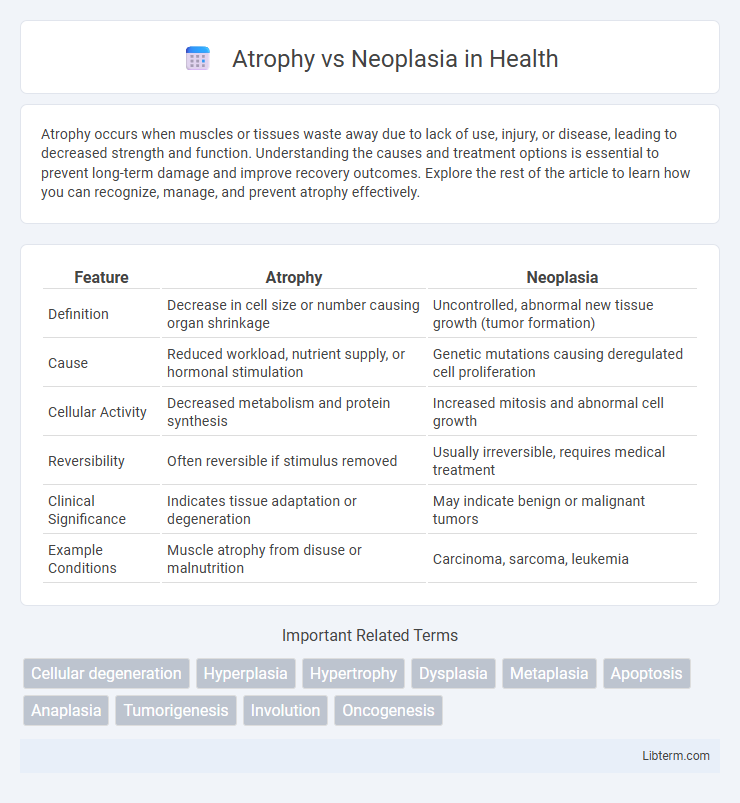Atrophy occurs when muscles or tissues waste away due to lack of use, injury, or disease, leading to decreased strength and function. Understanding the causes and treatment options is essential to prevent long-term damage and improve recovery outcomes. Explore the rest of the article to learn how you can recognize, manage, and prevent atrophy effectively.
Table of Comparison
| Feature | Atrophy | Neoplasia |
|---|---|---|
| Definition | Decrease in cell size or number causing organ shrinkage | Uncontrolled, abnormal new tissue growth (tumor formation) |
| Cause | Reduced workload, nutrient supply, or hormonal stimulation | Genetic mutations causing deregulated cell proliferation |
| Cellular Activity | Decreased metabolism and protein synthesis | Increased mitosis and abnormal cell growth |
| Reversibility | Often reversible if stimulus removed | Usually irreversible, requires medical treatment |
| Clinical Significance | Indicates tissue adaptation or degeneration | May indicate benign or malignant tumors |
| Example Conditions | Muscle atrophy from disuse or malnutrition | Carcinoma, sarcoma, leukemia |
Introduction to Atrophy and Neoplasia
Atrophy refers to the reduction in size and functional capacity of cells, tissues, or organs due to factors like decreased workload, inadequate nutrition, or aging. Neoplasia involves abnormal and uncontrolled cellular proliferation, leading to benign or malignant tumors, driven by genetic mutations and dysregulated growth signals. Both conditions represent distinct pathological adaptations with atrophy reflecting cellular regression and neoplasia showcasing excessive growth.
Defining Atrophy: Causes and Characteristics
Atrophy refers to the reduction in size and function of cells, tissues, or organs due to a decrease in cell size or number, often caused by factors such as disuse, ischemia, malnutrition, or aging. This adaptive response results in diminished cellular activity and metabolic rate, characterized by reduced protein synthesis and increased protein degradation. Unlike neoplasia, which involves abnormal and uncontrolled cell proliferation, atrophy represents a reversible process aimed at conserving energy under adverse conditions.
Understanding Neoplasia: Overview and Types
Neoplasia refers to the uncontrolled, abnormal growth of cells forming a neoplasm or tumor, which can be benign or malignant. Common types of neoplasia include carcinomas originating from epithelial cells, sarcomas arising from connective tissues, and hematologic malignancies such as leukemias and lymphomas. Recognizing the cellular origin and behavior of these neoplastic growths is essential for diagnosis, treatment, and prognosis in clinical oncology.
Key Differences Between Atrophy and Neoplasia
Atrophy is characterized by the reduction in cell size and number due to decreased workload, nutrient supply, or hormonal stimulation, leading to tissue shrinkage without new abnormal growth. Neoplasia involves uncontrolled, abnormal cell proliferation resulting in the formation of tumors, which can be benign or malignant. Key differences include atrophy's reversible cellular regression contrasted with neoplasia's irreversible and autonomous growth, often associated with genetic mutations and altered cell cycle regulation.
Cellular Mechanisms: Atrophy vs Neoplasia
Atrophy involves a reduction in cell size and metabolic activity due to decreased protein synthesis and increased protein degradation, often triggered by factors like nutrient deprivation or reduced workload. Neoplasia is characterized by uncontrolled cell proliferation caused by genetic mutations that lead to aberrant cell cycle regulation and resistance to apoptosis. The cellular mechanisms of atrophy emphasize adaptive survival through energy conservation, whereas neoplasia reflects pathological growth with disrupted homeostatic controls.
Clinical Presentations and Symptoms
Atrophy typically presents with gradual muscle weakness, decreased organ function, and visible tissue shrinkage, often linked to aging, disuse, or malnutrition. Neoplasia manifests through abnormal mass formation, persistent pain, unexplained weight loss, and organ dysfunction depending on tumor location and malignancy. Both conditions require clinical evaluation to distinguish between degenerative changes and neoplastic growths through imaging, biopsy, and symptom correlation.
Diagnostic Approaches for Atrophy and Neoplasia
Diagnostic approaches for atrophy primarily involve imaging techniques such as MRI and CT scans to detect tissue shrinkage, alongside histopathological examination revealing decreased cell size or number without atypia. Neoplasia diagnosis relies heavily on biopsy and histological analysis to identify abnormal cell proliferation, with immunohistochemistry and molecular testing providing critical information on tumor type and malignancy potential. Advanced imaging modalities like PET scans assist in assessing tumor metabolism and staging, differentiating neoplastic growth from benign atrophic changes.
Implications for Disease Progression
Atrophy involves the reduction in cell size or number, often leading to impaired tissue function and potential organ failure when prolonged. Neoplasia, characterized by abnormal and uncontrolled cell growth, frequently results in tumor formation with potential malignancy, driving disease progression through invasion and metastasis. Understanding these distinct cellular processes is crucial for targeted therapeutic strategies and prognosis assessment in diseases such as cancer and degenerative disorders.
Treatment Strategies and Management
Treatment strategies for atrophy primarily involve addressing the underlying cause to prevent further tissue degeneration, such as restoring adequate nutrition, enhancing blood flow, or mitigating chronic inflammation. Neoplasia management depends on the type and stage of the tumor, often combining surgery, chemotherapy, and radiation therapy to remove or control malignant cells. Targeted therapies and immunotherapy have become increasingly important in neoplastic treatment, improving outcomes through precision medicine approaches tailored to the tumor's molecular profile.
Prognosis and Prevention Strategies
Atrophy typically has a better prognosis because it involves reversible tissue shrinkage due to factors like reduced blood supply or disuse, making prevention strategies focused on lifestyle changes, nutritional support, and managing underlying causes effective. Neoplasia, involving abnormal and uncontrolled cell growth, often presents a variable prognosis dependent on the malignancy type, stage, and treatment response, with prevention strategies emphasizing avoiding carcinogens, early detection through screenings, and genetic counseling for high-risk individuals. Effective management of atrophy and neoplasia requires targeted interventions based on early diagnosis and risk factor modification to improve patient outcomes.
Atrophy Infographic

 libterm.com
libterm.com